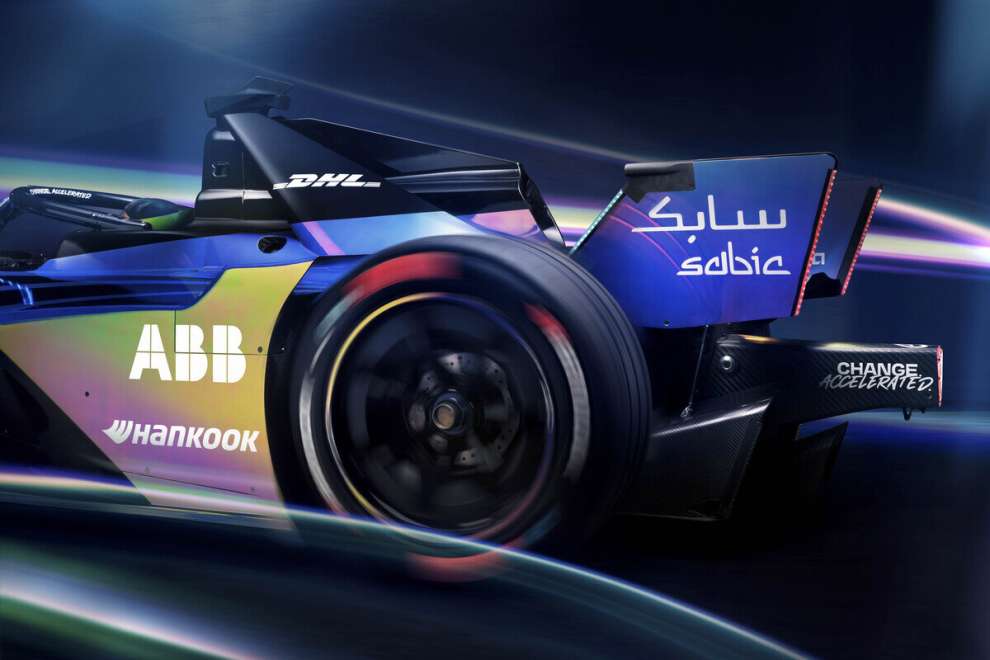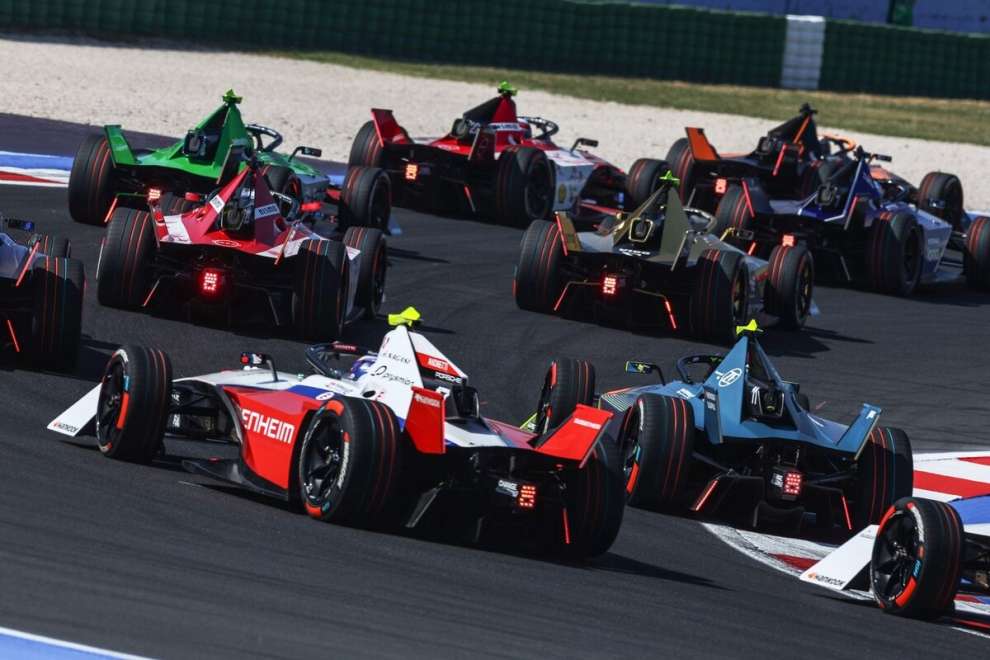By Carlo Platella
As per tradition, Formula E presents the evolved version of the current generation. An Evo car was also ready for the previous Gen2s, but the economic complications linked to the pandemic forced it to be abandoned. The Gen3, on the other hand, is preparing to change its skin, with a performance gain that almost seems like it a generational leap. In some respects, in fact, the new single-seater anticipates some of the concepts underlying the future Gen4, seeking ever-increasing performance to attract new spectators.
All-wheel drive arrives
Contrary to what happened with the evolution of the first generation, the increase in performance does not come through an increase in maximum power. This will remain constant at 350 kW during acceleration, equivalent to approximately 470 horsepower, tied to a battery that will not undergo alterations. On the other hand, the 350 kW will come now redistributed on all four wheels. The front engine, until now only used during braking to regenerate up to 50% of the energy needed to complete the race, will also be usable in the traction phase.
“The most important change is the opening to four-wheel drive”, explains Jeff Dodds, CEO of Formula E. “Until now the front generator has only been used to recharge the battery during braking, but from the Gen3 Evo both engines can be used during the push phase. All-wheel drive will be available at the start, in qualifying duels and during Attack Mode”. The four-wheel drive will improve acceleration performance by 30%, with the 0-100 sprint going from 2.7 to 1.86 seconds. These are record values, even lower than Formula 1, which averages around 2.6 seconds with peaks of 2.2 s.
So far, the effectiveness of Attack Mode has been one of the critical aspects of Gen3: “It depends on the tracks. In some there is clearly an advantage, while in others a little less,” comments Dodds. The new car, however, promises to cure this critical issue: “The plan with the Gen3 Evo is that Attack Mode will activate all-wheel drive. The number of minutes of activation will remain similar, but with four-wheel drive the impact will be greater”.
The eye wants its part
The most important change is hidden under the skin, but that doesn't stop the Gen3 Evo from showing off a new look. The most notable innovation is the front, with a biplane wing that is more blunt than the previous one and recalls the lines of the latest Gen1s. The entire car appears more streamlined and organic than it currently is, right down to the rear wheels, in front of which two small fins appear to help mitigate their impact on aerodynamic drag.
“There are small aerodynamic benefits, but we haven't spent tens of millions developing them”, explains Dodds. The primary purpose of the new bodywork, however, is to improve aesthetic appeal to the general public. “One of our goals was for enthusiasts to notice that it was a different car. We also wanted a more aggressive presence on the track, we wanted it to appear wider and more muscular. Finally, as a personal taste I preferred the front of the Gen2, which was more tapered compared to the triangular lines of the Gen3, which I don't particularly like. I think we achieved all three goals”.
“The upper bodywork has a much more masculine and aggressive appearance, thanks to less triangular and angular lines”continues the CEO. “Partly this was wanted for the aesthetic aspect, partly for the aerodynamics, but partly also for the stresses in the materials. In this way the bodywork breaks less easily in case of contact with the ground. All of this improves the rigidity and performance of the machine”. Improvements that justify the increase in the minimum weight to 857 kg: “To achieve this, we have developed a body 3 kg heavier of the previous one, but with small aerodynamic gains”confirms Dodds.

Two seconds less
Increasing performance was the priority for the development of the Gen3 Evo, as well as for the subsequent Gen4. However, the search for lap times is not an end in itself, but is functional to the growth of the championship. “A large part of racing fans want it seeing cars go faster and faster”, explains Dodds. An objective which, listening to the CEO, seems to have been fully achieved: “When I took on this position, one of the first things I saw was the development plan for the Gen3 Evo. Observing the work as an enthusiast rather than a CEO, I asked myself why not call it directly Gen4, because the performance leap is similar to that seen among previous generations. For many reasons, however, we wanted to stick to the four-year development cycle, even if for me the Gen3 Evo represents a generational leap.”
The Gen3 Evo promises a 2% improvement in lap times in qualifying, equivalent to just under 2 seconds on the Monte Carlo track. So far on the Monegasque track the Gen3 has not been particularly faster than the previous generation, despite the better power-to-weight ratio, limited above all by the excessive hardness of the tyres. However, a situation destined to change with the Gen3 Evo. “The new Hankooks will have between 5-10% more grip compared to current tires and have 35% recycled materials”promises the CEO. “I think it's very important to increase grip. Without grip, you wouldn't have the benefits of all-wheel drive.”

The slopes adapt
The desire to show the public the potential of the new cars encourages Formula E to explore an ever-increasing number of permanent circuits: “Traditionally we are a category that races in the city and we don't want to change this. However we will introduce a certain number of permanent circuits to promote different race dynamics, which we have already started to do.”
“With the Gen3 Evo there will be a number of permanent circuits where we will see more group racing. We will not abandon the permanent tracks, where in any case there could be 'cycling' race dynamics based on how much energy is given”. Formula E is aware that performance and entertainment will not depend solely on the cars, but will require a new generation of circuits designed with the same goal in mind: “We are evaluating different options for the calendar to showcase the potential of the car. For city slopes we are thinking of designs that go well with the car. For the permanent tracks, however, we evaluate configurations more similar to city circuits.”

The return of pit stops
The Gen3 was designed to carry out quick charging stops during the race, but technological complications then postponed its debut, which at this point seems destined to take place with the Evo car. Dodds comments: “We are trying to develop technologies that do not exist in the world. We want to charge 10% of a battery in 30 seconds. We tried it and we succeeded. However there are some small complications that we are trying to resolve. At the moment, however, if we were to debut fast charging in the race, we are not safe 100% that there would be no problems and no one wants to see a race decided by a failure of this type.”
“For me it makes sense to continue testing, with an intensive session in Valencia later in the year, to then introduce the technology in Season 11 with the Gen3 EVO”reassures the CEO. Overall, between all-wheel drive, aggressive look and higher-performance tyres, the Gen3 Evo anticipates the pillars of the future Gen4, indicated by many as an exciting project. “Gen4 will be a huge leap forward from the point of battery, overall power and stylistic design”, the promise of Jeff Dodds.
#Formula #4×4 #arrives #Gen3 #EVO #beat #pace